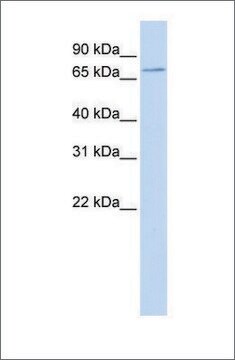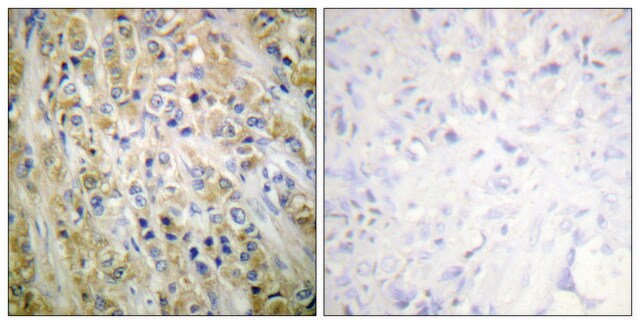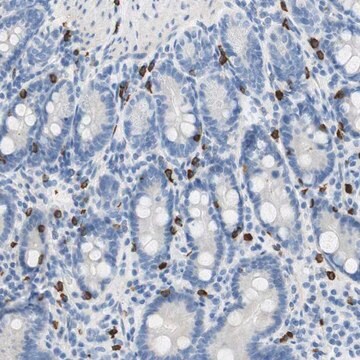ABC1454M
Anti-Sodium-Iodide Symporter Antibody, C-terminal 2
from rabbit
Synonym(s):
Sodium/iodide cotransporter, Na(+)/I(-) cotransporter, Na(+)/I(-) symporter
About This Item
IHC
IP
WB
immunohistochemistry: suitable (paraffin)
immunoprecipitation (IP): suitable
western blot: suitable
Recommended Products
biological source
rabbit
Quality Level
antibody form
affinity isolated antibody
antibody product type
primary antibodies
clone
polyclonal
species reactivity
human
technique(s)
flow cytometry: suitable
immunohistochemistry: suitable (paraffin)
immunoprecipitation (IP): suitable
western blot: suitable
isotype
IgG
NCBI accession no.
UniProt accession no.
target post-translational modification
unmodified
Gene Information
human ... SLC5A5(6528)
Related Categories
General description
Specificity
Immunogen
Application
Immunocytochemistry Analysis: A representative lot detected Sodium-Iodide Symporter in COS-7 cells transfected with wild-type human NIS and in COS-7 cells transfected with mutant Q267E human NIS (De la Vieja, A., et. al. (2005). Mol Endocrinol. 19(11):2847-58; De la Vieja, A., et. al. (2004). J Cell Sci. 117(Pt 5):677-87).
Immunohistochemistry Analysis: A representative lot detected Sodium-Iodide Symporter in Immunohistochemistry application (De la Vieja, A., et. al. (2004). J Cell Sci. 117(Pt 5):677-87; Wapnir, I.L., et. al. (2004). Clin Cancer Res. 10(13):4294-302; Wapnir, I.L., et. al. (2003). J Clin Endocrinol Metab. 88(4):1880-8).
Immunoprecipitation Analysis: A representative lot detected Sodium-Iodide Symporter in Biotinylated NIS constructs expressed in COS-7 cells (De la Vieja, A., et. al. (2004). J Cell Sci. 117(Pt 5):677-87).
Flow Cytometry Analysis: A representative lot detected Sodium-Iodide Symporter in COS-7 cells transfected with WT and mutant Q267E NIS (De la Vieja, A., et. al. (2004). J Cell Sci. 117(Pt 5):677-87).
Western Blotting Analysis: A 1:10,000 dilution from a representative lot detected Sodium-Iodide Symporter in COS-7 cells transfected with hNIS (Courtesy of Dr Nancy Carrasco & Dr. Andrea Reyna-Neyra at Yale University).
Western Blotting Analysis: A representative lot detected Sodium-Iodide Symporter in COS-7 cells transfected with NIS and COS-7 cells transfected with WT and mutant Q267E NIS (De la Vieja, A., et. al. (2005). Mol Endocrinol. 19(11):2847-58; De la Vieja, A., et. al. (2004). J Cell Sci. 117(Pt 5):677-87).
Immunohistochemistry Analysis: A representative lot detected Sodium-Iodide Symporter in IHC-P human salivary gland and breast tissues (Tazebay, U.H., et. al. (2000). Nat Med. 6(8):871-8).
Apoptosis & Cancer
Quality
Immunohistochemistry Analysis: A 1:50 dilution of this antibody detected Sodium-Iodide Symporter in human stomach tissue sections.
Target description
Physical form
Storage and Stability
Other Notes
Disclaimer
Not finding the right product?
Try our Product Selector Tool.
Storage Class Code
12 - Non Combustible Liquids
WGK
WGK 1
Flash Point(F)
Not applicable
Flash Point(C)
Not applicable
Certificates of Analysis (COA)
Search for Certificates of Analysis (COA) by entering the products Lot/Batch Number. Lot and Batch Numbers can be found on a product’s label following the words ‘Lot’ or ‘Batch’.
Already Own This Product?
Find documentation for the products that you have recently purchased in the Document Library.
Our team of scientists has experience in all areas of research including Life Science, Material Science, Chemical Synthesis, Chromatography, Analytical and many others.
Contact Technical Service








